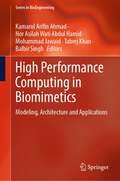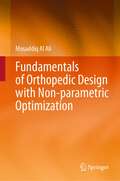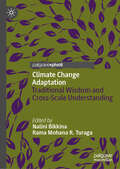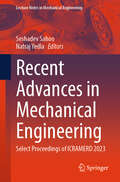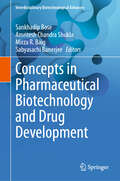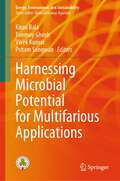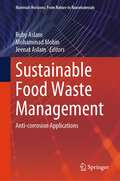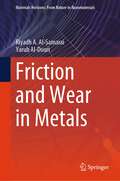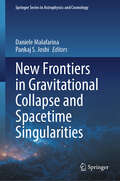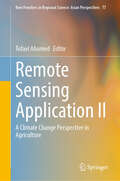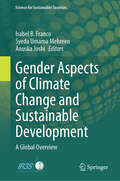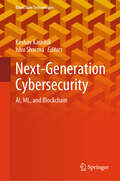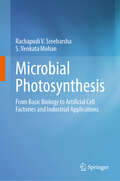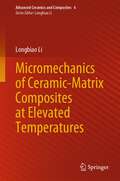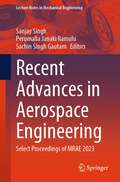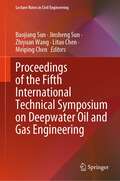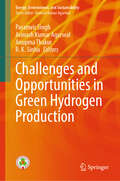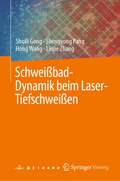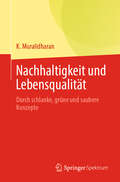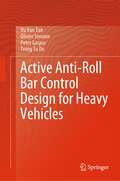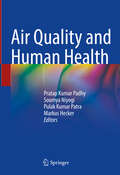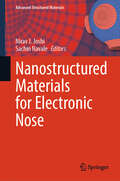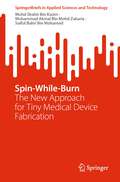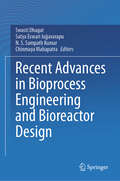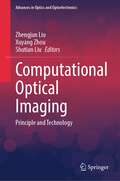- Table View
- List View
High Performance Computing in Biomimetics: Modeling, Architecture and Applications (Series in BioEngineering)
by Kamarul Arifin Ahmad Nor Asilah Wati Abdul Hamid Mohammad Jawaid Tabrej Khan Balbir SinghThis book gives a complete overview of current developments in the implementation of high performance computing (HPC) in various biomimetic technologies. The book presents various topics that are subdivided into the following parts: A) biomimetic models and mechanics; B) locomotion and computational methods; C) distributed computing and its evolution; D) distributed and parallel computing architecture; E) high performance computing and biomimetics; F) big data, management, and visualization; and G) future of high performance computing in biomimetics. This book presents diverse computational technologies to model and replicate biologically inspired design for the purpose of solving complex human problems. The content of this book is presented in a simple and lucid style which can also be used by professionals, non-professionals, scientists, and students who are interested in the research area of high performance computing applications in the development of biomimetics technologies.
Fundamentals of Orthopedic Design with Non-parametric Optimization
by Musaddiq Al AliThis book introduces a fundamental understanding of orthopedic design for both engineers and medical staff. It addresses the gap and mystery that often exists between these two fields and provides a common ground for understanding. The book covers various aspects of orthopedic design, including the anatomy and biomechanics of bones and joints, the materials used in orthopedic devices, and the testing and evaluation of orthopedic devices. It also introduces computer-aided design with additive manufacturing in a practical sense, including the principles of non-parametric optimization (topology and shape optimization) in a scientific and practical way. The author provides dedicated examples and research studies to further clarify the concepts presented in the book and includes some of their own peer-reviewed papers to support the material. Additionally, it covers the practical applications of computer-aided design and additivemanufacturing in orthopedic design, including the use of virtual prototyping, computer simulation, and 3D printing techniques. The book aims to provide a comprehensive guide to orthopedic design and the latest advancements in the field.
Climate Change Adaptation: Traditional Wisdom and Cross-Scale Understanding
by Nalini Bikkina Rama Mohana R. TuragaThis book discusses how climate change needs to be anchored in indigenous knowledge with reference to resource management, infrastructure, livelihoods, and social institutions, with a unique focus on risks and provenances of resilience available to the local communities. Beyond the scientific know-how on climate change, this volume highlights traditional wisdom, which through its hands-on learning plays a crucial role in amalgamation with cross-scale understanding. It documents the deliberations of a seminar that brought together traditional wisdom and cross-scale understanding of academicians, researchers, practitioners, and grassroots functionaries directly or indirectly working with communities in the area of climate change adaptation and thereby brings together adaptation and allied practices from across a spectrum of specialties and practitioner contexts. It discusses several insights and novel practices and is purported to provide significant research and policy implications in the spirit of thinking globally but acting locally.
Recent Advances in Mechanical Engineering: Select Proceedings of ICRAMERD 2023 (Lecture Notes in Mechanical Engineering)
by Seshadev Sahoo Natraj YedlaThis book presents select proceedings of the fourth International Conference on Recent Advances in Mechanical Engineering Research and Development (ICRAMERD 2023). The contents focus on latest research and current problems in various branches of mechanical engineering. Some of the topics discussed include fracture and failure analysis, fuels and alternative fuels, combustion and IC engines, advanced manufacturing technologies, powder metallurgy and rapid prototyping, industrial engineering and automation, vibrations and control engineering, automobile engineering, fluid mechanics and machines, heat transfer, composite materials, micro and nano-engineering for energy storage and conversion, and modeling and simulations. The book is useful for researchers and professionals in mechanical engineering.
Concepts in Pharmaceutical Biotechnology and Drug Development (Interdisciplinary Biotechnological Advances)
by Amritesh Chandra Shukla Sankhadip Bose Mirza R. Baig Sabyasachi BanerjeeThis book provides comprehensive coverage of the development of new pharmaceuticals and the enhancement of existing ones. It offers a comprehensive understanding of pharmaceutical biotechnology, including its underlying principles and practical applications from an industrial standpoint. While introducing the roles and applications of biotechnology in drug design and development, the book describes how developments in other fields, like genomics, proteomics, and high-throughput screening, have facilitated the discovery of novel therapeutic targets and drug development methods. It included concepts that are essential to biotechnology and apply to protein therapies. The book provides a thorough overview of the ways in which biotechnology influences drug development, production, and regulation, and is a valuable resource for those seeking to enhance their understanding in this area. This book is designed to support educators in their teaching efforts and offers a reader-friendly exploration of the various stages involved in developing new pharmaceuticals through biotechnology. This book is a valuable resource for individuals in various academic and professional careers, including undergraduates, graduates, pharmaceutical scientists, clinicians, and academic researchers. It provides convenient access to current practices in pharmaceutical biotechnology, making it particularly useful for those working in the interdisciplinary field of biochemistry, pharmacology, biopharmaceutics, and biotechnology. This book's concise and impartial content structure may also benefit corporate researchers.
Harnessing Microbial Potential for Multifarious Applications (Energy, Environment, and Sustainability)
by Kiran Bala Tonmoy Ghosh Vivek Kumar Pritam SangwanThis book discusses the current state of strategies that utilize the ability of microbes to remediate waste sources, such as wastewater streams and mine tails, and provide environmentally friendly options to mitigate soil and water pollution caused due to heavy metals. It also provides details about the development of biodegradable plastics from microbial sources and how they can be economical and greener alternatives to the currently used options. It will act as a single platform for combining the remedial powers of microbes which can be both sustainable and practical under a single volume. This text will be particularly useful for govt. institutions, academicians, and industry professionals, who deal in wastewater remediation and sustainability of currently used sources of plastics and other high-value metabolites. It will also be of practical help to engineers involved in remediation processes for wastewater and industrial waste.
Sustainable Food Waste Management: Anti-corrosion Applications (Materials Horizons: From Nature to Nanomaterials)
by Ruby Aslam Mohammad Mobin Jeenat AslamThis book highlights established research and technology on corrosion inhibitors and bio-waste management. It further discusses emerging aspects of utilizing food waste in the field of corrosion inhibition. The topics covered include overview on bio-waste and their management, different types of food waste (i.e., agricultural, vegetable and fruit/fruit juice, plant waste, slaughterhouse trash), and their application as corrosion inhibitors and mitigation of corrosion. It also discusses economic aspects and commercialization of food waste as corrosion inhibitors. The book is a valuable reference for beginners, researchers, and professionals working in the areas of sustainability, food waste management, and material science.
Friction and Wear in Metals (Materials Horizons: From Nature to Nanomaterials)
by Riyadh A. Al-Samarai Yarub Al-DouriThis book focuses on tribology in manufacturing processes from the viewpoint of sliding friction fundamentals, the use of lubricants to control friction processes such as machining, drawing, rolling, extrusion, abrasive processes, and processing at micro and nanoscales. To study tribological behavior, it is essential to know the methods of measuring and describing the surface shape and roughness. The friction and wear, their corresponding coefficients, and their main mechanisms are described, including stick-slip effects, adhesion, and plowing. Adhesive, abrasive, erosive, and erosion-corrosion wear mechanisms. Friction–wear relationships are elaborated, and wear maps are presented. Surface interactions depend on the contacting materials and surface shape. It is a function of the production process and nature of parent materials that are found to be rough, where roughness is characterized by asperities of varying amplitudes and spacing. Surface interactions are dependent both on thecontacting materials and the shape of the surface. The distribution of the asperities is directional when the finishing process is direction-dependent, such as turning, milling, etc., and homogeneous for a non-directional finishing process like lapping, electro-polishing.
New Frontiers in Gravitational Collapse and Spacetime Singularities (Springer Series in Astrophysics and Cosmology)
by Pankaj S. Joshi Daniele MalafarinaThe book collects a series of articles to review the advances that have been made in the field of gravitational collapse in general relativity and alternative theories of gravity in the past few years. Many approaches to black hole and singularity formation in general relativity and beyond have been proposed over the last few decades. The importance of collapse models is that they provide natural thought experiments where to test the behavior and properties of a variety of approaches to general relativity and its implications for ultra-compact objects in the universe.
Remote Sensing Application II: A Climate Change Perspective in Agriculture (New Frontiers in Regional Science: Asian Perspectives #77)
by Tofael AhamedThis book focuses solely on the issues of agricultural productivity analysis with advanced modeling approaches bringing solutions to food-insecure regions of the world, especially in south and southeast Asia and in Africa. Advanced modeling tools and their use in regional planning provide an outstanding opportunity to help face the challenges of climate change. The sudden effect of flash floods, drought, salinity, and sea water rises causing saltwater intrusions and its impact on agricultural production are some of the disastrous results of climate change. In this edited volume, information on climate-induced impacts for flooding, flash floods, and drought impact on agricultural crops is provided to address possible solutions for food security in south Asia, southeast Asia, and some regions of Africa. Leading-edge research methodology is presented as it relates to remote sensing applications for regional science and allied fields. In regional policy planning, agriculture andforestry play key roles in food security along with environmental conservation and depend on geo-spatial variability. Satellite remote sensing and geographical information systems have an immense potential to encompass all these factors and to catalogue the regional variability of climate change and climate economics. In the satellite remote sensing domain, advanced modeling tools, deep learning applications, and cloud-based earth engines significantly increase the flexibility of decision making and its application for regional perspectives. The result can increase agricultural and forest productivity and ensure its resilience and sustainability. The book’s chapters introduce modeling techniques such as machine learning and fuzzy expert system using satellite remote sensing datasets based on cloud application. These methods assist regional planners to increase crop production, land use, and detection of changes in land cover in order to better understand their vulnerability toclimate-related disaster. Furthermore, remote sensing and in-depth GIS analysis are integrated with machine learning to address natural uncertainties such as flash floods, droughts, and cyclones so that emergency responses for agricultural production management can be adopted more effectively.
Gender Aspects of Climate Change and Sustainable Development: A Global Overview (Science for Sustainable Societies)
by Isabel B. Franco Syeda Umama Mehreen Anuska JoshiThis book addresses how sustainability discourse and advocacy can translate to impactful policies especially when bridging the divide between sustainability, climate change and gender. The book explores various areas, such as conservation, climate action, sustainable fashion, and corporate sustainability, and defines the existing sustainability gaps in the selected cases (country/sector/region). It highlights the value of sustainability science and climate change on innovative approaches to research, education, capacity-building, and practice to transform rhetoric into impact sustainability while encompassing cases from various industries, sectors, and geographical contexts. While emphasizing SDG 5, the book chapters also show the transboundary implications of gender equality and inclusivity to other sustainable development and climate change goals and targets. The contributions are exemplary in highlighting the relation of gender inclusivity in strengthening efforts to protect andsafeguard the world’s cultural and natural heritage and making cities and human settlements inclusive and safe (Goal 11), protecting, restoring, and promoting sustainable management of terrestrial ecosystems and reverse land degradation (Goal 15), ensuring access to affordable, reliable, sustainable and modern energy for all (Goal 7), promoting sustainable and inclusive economic growth with productive and decent employment for all (Goal 8), promoting inclusive and sustainable industrialization (Goal 9), adopt policies to reduce inequalities (Goal 10), ensure sustainable consumption and production pattern (Goal 12), addressing climate change impacts and building resilience (Goal 13), and ensuring availability and sustainable management of water and sanitation for all (Goal 6).
Next-Generation Cybersecurity: AI, ML, and Blockchain (Blockchain Technologies)
by Keshav Kaushik Ishu SharmaThis book highlights a comprehensive overview of the recent advancements and challenges in the field of cybersecurity with a focus on the integration of artificial intelligence (AI), machine learning (ML), and blockchain technologies. The book targets both researchers and practitioners working in the field of cybersecurity and aims to fill the gap in the current literature by providing a comprehensive and up-to-date examination of the integration of AI, ML, and blockchain in cybersecurity systems. The book has a technical focus and provides an in-depthexamination of the latest developments in the field. It covers a range of topics including the basics of AI, ML, and blockchain, the application of AI and ML in cybersecurity, the use of blockchain in cybersecurity, and the integrationof AI, ML, and blockchain in cybersecurity systems. Each chapter is written by leading experts in the field and provides a thorough and technical overview of the topic, including case studies, examples, and practical applications.
Microbial Photosynthesis: From Basic Biology to Artificial Cell Factories and Industrial Applications
by Rachapudi V. Sreeharsha S. Venkata MohanThis book uncovers the basic principles of microbial photosynthesis and the latest technological interventions of this crucial phenomenon. In the recent past, the basic principles of microbial photosynthesis were technologically articulated to engineer several cell factories that can utilize waste resources and generate different groups of industrially valuable products. Also, the list of model organisms for specific usage have been increasing enormously. This volume covers the material in four sections; each of the part dealing with the basic principles of microbial photosynthesis in an applied orientation focusing on waste valorization and circular bioeconomy. Furthermore, the following chapters deal with the very recent advancements in metabolic engineering and artificial photosynthesis with respect to value addition. Not only will this book be available for graduate and postgraduate students in microbiology, biotechnology, plant sciences, environmental sciences, energy engineering, and renewable energy, it is also an excellent material for researchers needing a multidisciplinary approach.
Micromechanics of Ceramic-Matrix Composites at Elevated Temperatures (Advanced Ceramics and Composites #6)
by Longbiao LiCeramic-matrix composites (CMCs) possess high specific strength and modulus at elevated temperature, and have already been applied in hot-section components in aero-engines. To ensure the operation reliability and safety of CMCs components, it is necessary to understand the micro damage mechanisms and internal damage state in the composites. This book focuses on the micromechanics of CMCs at elevated temperatures, including, the stress-strain behavior, proportional limit stress, residual strength, mechanical hysteresis, interface damage, strain response, and lifetime of CMCs at elevated temperatures. This book can help the material scientists and engineering designers to better understand and master the micromechanics of CMCs at elevated temperatures.
Recent Advances in Aerospace Engineering: Select Proceedings of MRAE 2023 (Lecture Notes in Mechanical Engineering)
by Sanjay Singh Perumalla Janaki Ramulu Sachin Singh GautamThe book presents the select proceedings of 2nd International Conference on Modern Research in Aerospace Engineering (MRAE 2023). It covers the latest research in the field of aerospace engineering and space technology. Various topics covered in this book are aerospace propulsion; space research; avionics and instrumentation; aerodynamics, wind tunnel and computational fluid dynamics; structural analysis and finite element method; aerospace materials and manufacturing system; air safety and airworthiness; aircraft control system and stability; aircraft maintenance, overhauling, NDT and other technical tests; autonomous airborne systems; airborne defence systems; AI and ML applications in aerospace engineering; unmanned aerial vehicles and flight mechanics. The book will be useful for researchers and professionals in aerospace engineering and space science and technology.
Proceedings of the Fifth International Technical Symposium on Deepwater Oil and Gas Engineering (Lecture Notes in Civil Engineering #472)
by Baojiang Sun Jinsheng Sun Zhiyuan Wang Litao Chen Meiping ChenThis book is a compilation of selected papers from the Fifth International Technical Symposium on Deepwater Oil and Gas Engineering and the Fourth International Youth Forum on Gas Hydrate (DWOG-Hyd 2023), held in Qingdao, China, in October 2023. The book focuses on the advancement of techniques for the deepwater oil and gas exploitation and natural gas hydrate exploitation. The book introduces new ideas for exploring deepwater oil, gas and hydrate in a safe and efficient way. Advances of the deepwater oil, gas and hydrate drilling and production in South China Sea, in oil and gas flow assurance and emerging technologies based on clathrate hydrate will be presented. It is a valuable resource for both practitioners and academics working in the field of deepwater oil and gas engineering.
Challenges and Opportunities in Green Hydrogen Production (Energy, Environment, and Sustainability)
by Avinash Kumar Agarwal Paramvir Singh Anupma Thakur R. K. SinhaThis book comprehensively explores the dynamic landscape of green hydrogen, a transformative energy carrier. It offers a resource for researchers, professionals, and policymakers in sustainable energy. Starting with foundational understanding, it delves into hydrogen's importance, production methods, and climate change mitigation. This timely contribution addresses a knowledge gap by integrating green hydrogen's multifaceted aspects. By integrating multifaceted aspects, from fundamental principles to cutting-edge applications and societal implications, it provides a holistic grasp of green hydrogen's scientific, technological, and policy dimensions. The book navigates the intricate journey of green hydrogen production, spotlighting catalytic and technological breakthroughs, renewable energy integration, electrolyzer systems, and material strategies. Industrial applications and environmental impacts are detailed, covering life cycle assessments, water use, land considerations, and policy insights. This book caters to a diverse readership invested in sustainability and renewable energy transition. This book's multidisciplinary expertise guides the energy transition, fostering informed decision-making and inspiring collaboration. Policymakers, entrepreneurs, environmental experts, and researchers can find crucial implications, gain strategic insights, and explore ecological aspects. It endeavors to equip stakeholders with the knowledge, insights, and foresight needed to usher in a sustainable energy paradigm.
Schweißbad-Dynamik beim Laser-Tiefschweißen
by Hong Wang Shuili Gong Shengyong Pang Linjie ZhangDiese Buch beschreibt systematisch das Schweißbadverhalten beim Laser-Schweißen und dessen Einflussfaktoren aus Perspektiven der Prüftechnologie, theoretischen Berechnung und Prozesssimulationstechnologie, des physikalischen Zustandsverhaltens von Schweißbädern sowie der Auswirkungen technischer Bedingungen auf das Schweißbadverhalten. Das Buch umfasst umfangreiche Forschungsleistungen, die in China auf diesem Gebiet erzielt wurden, einige davon repräsentieren die neuesten Spitzenforschungen des Autorenteams. Diese neuesten Forschungsanstrengungen beziehen sich hauptsächlich auf das Schweißbadverhalten beim Zweistrahlen-Laserschweißen, das Laserschweißen mit Zusatzdrähten, das Vollpenetrations-Laserschweißen von sehr dicken Teilen und das Laserschweißen unter Vakuum- und Niederdruckbedingungen. Das Buch richtet sich an Bachelor- und Masterstudierende sowie Forscher, die sich für das Laser-Schweißen interessieren.
Nachhaltigkeit und Lebensqualität: Durch schlanke, grüne und saubere Konzepte
by K. MuralidharanDieses Buch soll die Leser für das Thema Nachhaltigkeit sensibilisieren und sie ermutigen, die Bedeutung von „lean, green and clean“ (LGC) für den Alltag zu verstehen. Die Notwendigkeit von auf Messungen basierten Auswertungen, statistische Signifikanz bei Materialverbrauch und Energie werden erörtert. Das Buch konzentriert sich auf die Bedeutung von Fragen des Klimawandels und Umweltbelangen im Zusammenhang mit schlanker Produktion und Fertigung. Der Schwerpunkt liegt auf dem Verständnis und der Anwendung von Qualitätskonzepten durch Projektmanagement und messbasierte Bewertungsmethoden. Dieses Buch richtet sich an ein breites Publikum, darunter Studierende, Lehrkräfte, Qualitätsfachleute, Unternehmensberater, Lean- und Six-Sigma-Praktiker, und ist für sie von großem Nutzen.Die Übersetzung wurde mit Hilfe von künstlicher Intelligenz durchgeführt. Eine anschließende menschliche Überarbeitung erfolgte vor allem in Bezug auf den Inhalt.
Active Anti-Roll Bar Control Design for Heavy Vehicles
by Vu Van Tan Olivier Sename Peter Gaspar Trong Tu DoThis book provides a comprehensive overview of active anti-roll bar systems on heavy vehicles as one of the most effective solutions for improving the roll stability of these vehicles. Due to the characteristics of these vehicles with heavy loads and high center of gravity, the possibility of roll instability occurs frequently and causes serious consequences for human life, vehicles, and traffic infrastructure. The book gives readers an in-depth survey of the roll instability characteristics of heavy vehicles such as single-unit trucks with rigid and flexible frames, and tractor semi-trailers. It then introduces an active anti-roll bar system, the electro-hydraulic actuators which use control methods such as LQR optimal and H∞ robust controller design. This work introduces a new control method, which is a combination of robust control with the linear parameter varying system (H∞/LPV). The validation of the new hybrid method is carried out using the nonlinear truck model from the TruckSim® software to assess the roll stability of heavy vehicles in order to limit the rollover accident. A number of examples are provided to illustrate the research results, which helps the readers have a practical and easy approach that can be applied to other active anti-roll bar systems for most forms of transport vehicles in general. This book caters to academics and practitioners who are interested in active anti-roll bar systems for the typical heavy vehicle available worldwide.
Air Quality and Human Health
by Markus Hecker Pratap Kumar Padhy Soumya Niyogi Pulak Kumar PatraThe book is one of the outcomes of the SPARC (Scheme for Promotion of Academic and Research Collaboration) project titled "Fine particulates matters in the air environment and their cancer risks in human beings," sponsored by MHRD (now MoE), Govt. of India. The editors of the book are PIs and Co-PIs of the said project. The text deliberates on air pollution's health risks with contributions from well-known experts from diverse research fields (environmental science, toxicology, geology, public health science, biology, physics, chemistry, and geospatial technology). It explores it its control and mitigation strategies. The book provides an up-to-date overview of the modern methods and tools used in air quality monitoring and human health risk assessment. Case studies from different global settings offer invaluable insights into air pollution-related regional health issues. It addresses all aspects of air quality, covering indoor-outdoor air pollution, gaseous and particulate pollutants; characterization of source and pathways of air pollutants; and the modeling and assessing of health risks (respiratory, epidemiological, and toxicological) with regional and global perspectives. It also addresses air quality management issues. The lucid explanation of the role of oxidative stress mechanisms and molecular biomarkers (genomics, proteomics) may be considered as inputs into the development of cancer therapeutics. Along with providing a scientific basis for air pollution, this book will help readers appreciate the environmental determinants of public health and apply research evidence to improve the quality of life. It also delineates future research initiatives and policy actions needed to protect human health from air pollution, locally and globally. The book will be of great educational value and help for consultation and teaching.
Nanostructured Materials for Electronic Nose (Advanced Structured Materials #213)
by Nirav J. Joshi Sachin NavaleThis book presents recent developments and fascinating attributes of electronic-nose (E-nose) technology based on advanced nanostructured materials that are compatible with modern semiconductor fabrication technology. The new trend in these nanostructured materials includes metal oxide nanostructures, 2D materials, graphene, and other carbon-based nanostructures. These versatile materials with remarkable electronic, mechanical, electrical, thermal properties, and potential e-nose in a wide range of fields are discussed in the book. Close attention is given to problems connected with stability, selectivity, and functionalizing of e-nose devices and deposited materials. The field of sensors is indeed in fast and consistent growth. This book consolidates information on each and every aspect of these novel materials, their gas sensing mechanisms, engineering, and e-nose devices covering the entire spectrum of up-to-date literature citations, current market, and patents in a very detailed manner. Moreover, in the past few years, tremendous advances have been made in experimental and theoretical studies on various properties of these materials. In summary, this book makes an attempt to provide in-depth study of recent advances and focuses on current problems related to selectivity and stability of sensor devices. The book is interesting to all materials professionals and researchers from universities and national laboratories working in the field of nanostructured materials-based gas sensors.
Spin-While-Burn: The New Approach for Tiny Medical Device Fabrication (SpringerBriefs in Applied Sciences and Technology)
by Mohd Shahir Kasim Muhammad Akmal Zakaria Saiful Bahri MohamedThis book explains the challenges and advancements in cutting precise cylindrical shapes on difficult materials through spark erosion. Titled "Spin while Burn," it addresses the drawbacks associated with this process, including unsatisfactory surface finish and limited productivity. Despite utilizing advanced computing and statistical optimization methods, achieving the ideal balance between material removal rate (MRR) and surface quality remains elusive. In response, the book introduces a hybrid ultrasonic-assisted approach in the wire electrical discharge turning (WEDT) process. By integrating a rotating workpiece with ultrasonic vibration, the authors evaluate its impact on MRR and surface finish. Through meticulous design experiments and statistical analysis, they explore various cutting parameters and machining paths. The book highlights the characterization of machined surfaces through elemental analysis and surface morphology evaluations. The results demonstrate the positiveeffects of integrating ultrasonic vibration into WEDT, even without optimized ultrasonic parameters. By reducing electrode wire debris and employing multi-objective parameter optimization using the genetic algorithm, significant improvements are achieved in MRR and surface roughness compared to conventional WEDT. "Spin while Burn" consists of five chapters, delving into the challenges, history, principles, performance, and future perspectives of the Spin-while-Burn process in manufacturing. This comprehensive book offers valuable insights into enhancing surface quality and productivity in the cutting of precise cylindrical shapes on challenging materials through spark erosion.
Recent Advances in Bioprocess Engineering and Bioreactor Design
by Swasti Dhagat Satya Eswari Jujjavarapu N. S. Sampath Kumar Chinmaya MahapatraThis book provides insights into the recent developments in the field of bioprocess technology and bioreactor design. Bioprocess engineering or biochemical engineering is a subcomponent of chemical engineering, which encompasses designing and developing those processes and equipment that are required for the manufacturing of products from biological materials and sources, such as agriculture, pharmaceutical, chemicals, polymers, food, etc., or for the treatment of environmental process, for example, waste water. The main focus of this book is to highlight the advancements in the field of bioprocess technology and bioreactor design. The book is divided into various chapters briefing all aspects of bioprocess engineering and focusing on the advances in bioprocess engineering. The book summarizes introduction to bioprocess technology and microbiology, isolation and maintenance of microbial strains, and sterilization techniques for advanced-level students and researchers. Different models depicting kinetics of microbial growth, substrate consumption, and product formation are discussed. The applications of enzymes have increased tremendously and therefore understanding their metabolic pathways to increase yields is also briefly discussed. The calculations of mass and energy balances associated with entropy changes and free energy. This book also covers the approaches for handling different types of cell cultures and current advancements in the area of bioprocess strategies for different culture types, which scientists and researchers working in the different cell cultures can refer to. The downstream processing of various industrially important products is also a part of this book. Apart from that, the process economics which ensures the feasibility and quality of any biological process is also dealt with as the last section of the book.
Computational Optical Imaging: Principle and Technology (Advances in Optics and Optoelectronics)
by Zhengjun Liu Xuyang Zhou Shutian LiuThis book highlights a comprehensive introduction to the principles and calculation methods of computational optical imaging. Integrating optical imaging and computing technology to achieve significant performance improvements, computational optical imaging has become an active research field in optics. It has given rise to the emerging of new concepts such as computational imaging, computational measurement and computational photography. As high-performance image detectors make image measurements discrete and digital, images are mostly recorded in the form of discrete data, almost replacing the continuous medium used for pattern recording. Computational optical imaging technology has become an effective way for people to study microscopic imaging. At present, different imaging systems are composed of continuous optical elements such as lenses and prisms or discrete optical elements such as spatial light modulators or digital micro-mirror devices. The current computing technology has permeated all aspects of imaging systems and gradually promotes the digitization of optical imaging systems. This book summarizes the representative work done in this field and introduces the latest results. Computing technology plays an important bridging role between theories of optics and experimental systems, which inspires more comprehensive and in-depth research. It has the advantages of high repeatability, flexibility, strong computing power and low cost. In this multidisciplinary field, researchers in computer science, optics and information science have joined together to extend its depth and breadth. Targeting cutting-edge issues to be solved in computational optics, this book introduces a variety of methods that involve theoretical innovations and technical breakthroughs in imaging resolution, the field of view, imaging speed, and computing speed. It intends to provide a handy reference and technical support for graduate students, researchers and professionals engaged in the study and practice of computational optical imaging.
